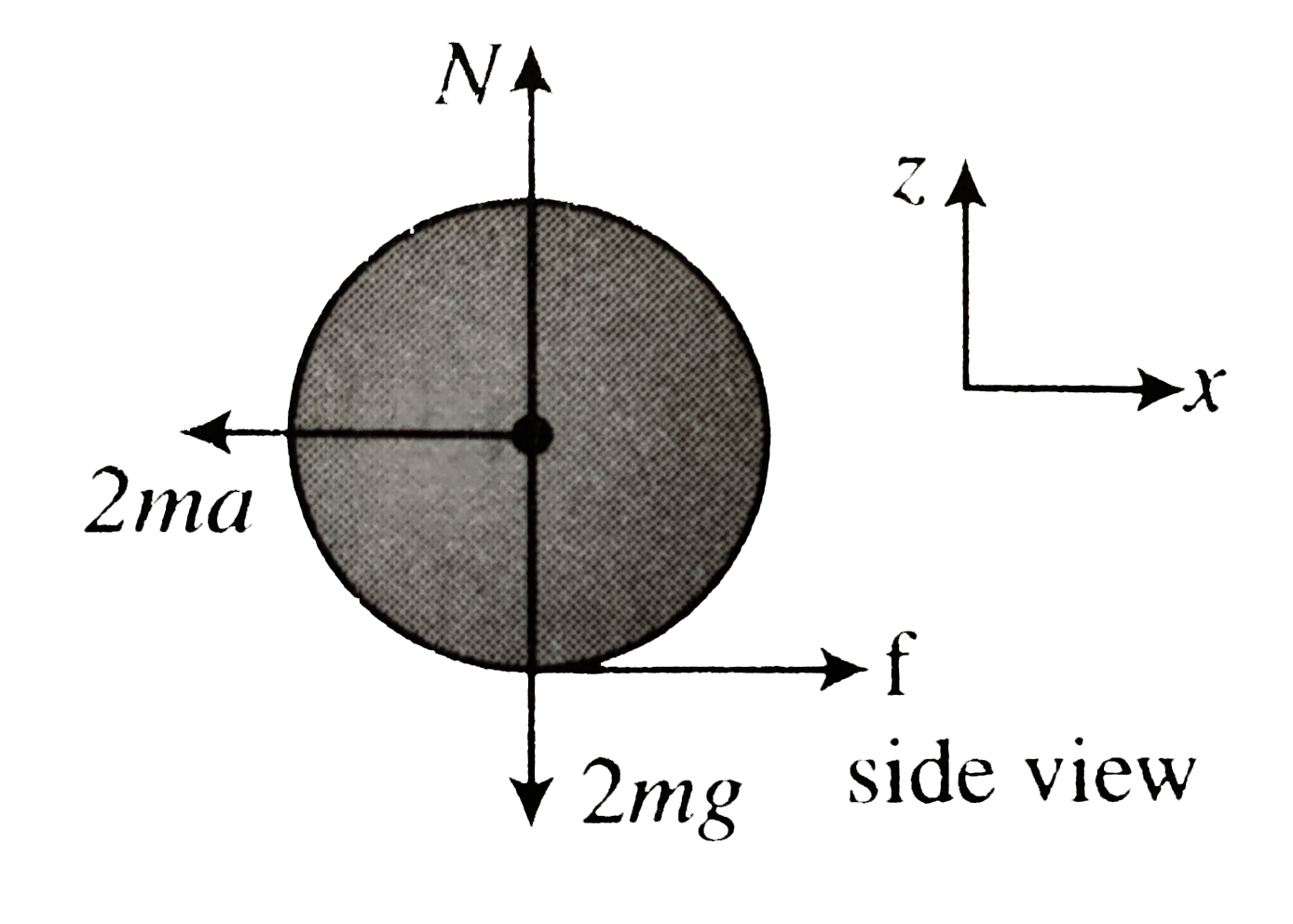Two thin circular disks of mass 2kg and radius 10 cm each are joined by a rigid massless rod of length 20 cm. the axis of the rod is along the perpendicular to the planes of the disk through their centres. This object is kept on a truck in such a way that the axis of the object is horizontal and perpendicular to the direction of the motion of the truck. Its friction with the floor of the truck is large enough so that the object can roll on the truck without slipping. Take x axis as the direction of motion of the truck and z-axis as the vertically upwards direction. if the truck has an acceleration of 9m/s2 Calculate:
(i) The force fo friction on each disk,
(ii) The magnitude and the direction of the frictional torque acting on each disk about the centre of mass O of the object. Express the torque in the vector form in terms of unit vectors ˆi,ˆjandˆk in the x,y, and z directions.

a. FBD of the object with respect to truck

In the reference frame of truck it experiences a pseudoforce
→F=−2maˆi
where a= acceleration of the truck.
Pseudoforce does not provide torque about the centre of the disc. Because of this force, object has tendency to side along −ve x-axis. Hence frictional force will act along +ve x-axis.
For translational motion
2ma−f=2ma' ..........i
Here a'=acceleratioin of the centre of mass of the object.
For rotational motion fR=Iα
for on slipping α=a'R
Hence f.R=2(mR22)(a'R)
⇒a'=fm.........ii
From eqn i and ii we get f=23maˆi
Therefore force of friction on each disc is
f2=maˆi=6ˆi

b. →f1=ma3ˆi
→r1=−lˆj−Rˆk⇒τ(f1)=→r1×→f1
=−(lˆj+Rˆk)×ma3ˆi
−maR3ˆj+mal3ˆk
=6×0.1ˆj+6×0.1ˆk
=−0.6ˆj+0.6ˆk
τ(f2)=−0.6ˆj−0.6ˆjk
c. Maximum value of frictional force is 2μmg
⇒23m≤2μmg⇒≥a3g
Topper's Solved these Questions
- RIGID BODY DYNAMICS 2BOOK - CENGAGE PHYSICS ENGLISHCHAPTER - RIGID BODY DYNAMICS 2EXERCISE - Exercise 3.1
11 Videos
- RIGID BODY DYNAMICS 2BOOK - CENGAGE PHYSICS ENGLISHCHAPTER - RIGID BODY DYNAMICS 2EXERCISE - Exercise 3.2
13 Videos
- RIGID BODY DYNAMICS 2BOOK - CENGAGE PHYSICS ENGLISHCHAPTER - RIGID BODY DYNAMICS 2EXERCISE - Interger
2 Videos
- RIGID BODY DYNAMICS 1BOOK - CENGAGE PHYSICS ENGLISHCHAPTER - RIGID BODY DYNAMICS 1EXERCISE - Integer
11 Videos
- SOUND WAVES AND DOPPLER EFFECTBOOK - CENGAGE PHYSICS ENGLISHCHAPTER - SOUND WAVES AND DOPPLER EFFECTEXERCISE - Integer
16 Videos
Similar Questions
Two point masses m and 4m are connected by a light rigid rod of length l at the opposite ends. Moment of inertia of the system about an axis perpendicular to the length and passing through the centre of mass is
View SolutionA circular disc of mass 100 g and radius 10 cm' is making 2 rps about an axis passing through its centre and perpendicular to its plane. Calculate its kinetic energy.
View Solution
Knowledge Check
Two thin discs each of mass M and radius r metre are attached to form a rigid body as shown in figure. The rotational inertia of this body about an axis perpendicular to the plane of disc B and passing through its centre is
 A2Mr2B3Mr2C4Mr2D5Mr2
A2Mr2B3Mr2C4Mr2D5Mr2Two masses each of mass M are attached to the end of a rigid massless rod of length L. The moment of interia of the system about an axis passing centre of mass and perpendicular to its length is.
AML2/4BML2/2CML2D2ML2The radius of gyration of an uniform rod of length l about an axis passing through one of its ends and perpendicular to its length is.
Al√2Bl3Cl√3Dl2
Two spheres each of mass M and radius R/2 are connected with a massless rod of length R. Find the moment of inertia of the system about an axis passing through the centre of one of the sphere and perpendicular to the rod
View SolutionTwo identical rods each of mass M and length L are kept according to figure. Find the moment of inertia of rods about an axis passing through O and perpendicular to the plane of rods.

View SolutionA thin rod of length L of mass M is bent at the middle point O at an angle of 60∘. The moment of inertia of the rod about an axis passing through O and perpendicular to the plane of the rod will be

View SolutionLet M be the mass and L be the length of a thin uniform rod. In first case, axis of rotation is passing through centre and perpendicular to the length of the rod. In second case, axis of rotation is passing through one end and perpendicular to the length of the rod. The ratio of radius of gyration in first case to second case is
View SolutionFour thin rods of same mass and same length L form a square Radius of gyration of this system about an axis which is perpendicular to plane of square and passes through its centre is
View Solution
